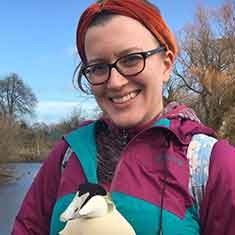Dr Alex Nicol-Harper
Principal Research Officer, Wetland Bioscience
Contact details
Twitter - @alexnicolharper

About me
I have been involved with WWT since 2014 when I was a summer volunteer in the duckery at Slimbridge – involving lots of mucking out but also many fluffy ducklings. I subsequently applied my academic background in biology towards informing conservation, with a PhD on seabird breeding ecology from the University of Southampton in collaboration with WWT. Focusing on the common eider, I used mathematical modelling to investigate the relationships between vital rates (clutch size, adult survival, etc.) and population growth rate, to assess which life-stages might be the best targets for monitoring and intervention. I was able to contribute to AEWA’s International Single Species Action Plan for the Common Eider in Europe, and we hope that our findings will also inform management of other seaducks – many of which are threatened and/or little-studied. Since 2021, I have also been an Associate Trustee for the Hampshire & Isle of Wight Wildlife Trust.
My role
I provide scientific support to WWT’s species recovery programmes, which currently include Project Godwit and a range of interventions for the Eurasian curlew. Prior to this role, I analysed the WWT/Birds Russia headstarting programme for the Critically Endangered Spoon-billed Sandpiper, and will be extending investigations of early-life effects to other headstarting programmes. For example, is it better to collect eggs as soon as they are laid or later in incubation, and at what age should we aim to release fledglings? This will allow us to optimise rear-and-release protocols and hence boost populations through a net gain in productivity.
In the future, my work will likely cover additional wetland keystone and flagship species, as well as a broader consideration of the role of rewilding within wetland restoration. I will also be helping to communicate our species recovery science to a range of audiences including academics, policymakers, and WWT staff and supporters.
Experience and interests
- R programming
- Population modelling
- Data synthesis and meta-analysis
- Interdisciplinary scientific writing
- Public engagement
Publications
- Nicol‐Harper, A., Doncaster, C. P., Hilton, G. M., Wood, K. A., & Ezard, T. H. G. (2023). Conservation implications of a mismatch between data availability and demographic impact. Ecology and Evolution, 13(7), e10269. https://doi.org/10.1002/ece3.10269
- Fay, R., … Nicol-Harper, A., … & Sæther, B-E. (2022). Quantifying fixed individual heterogeneity in demographic parameters: Performance of correlated random effects for Bernoulli variables. Methods in Ecology and Evolution, 13(1), 91-104. https://doi.org/10.1111/2041-210X.13728
- Fay, R., … Nicol-Harper, A., ... & Sæther, B-E. (2022). Temporal correlations among demographic parameters are ubiquitous but highly variable across species. Ecology Letters, 25(7), 1640-1654. https://doi.org/10.1111/ele.14026
- Nicol-Harper, A., Wood, K. A., Diamond, A. W., Major, H. L., Petersen, A., Tertitski, G., Doncaster, C. P., Ezard, T. H. G., & Hilton, G. M. (2021). Vital rate estimates for the common eider Somateria mollissima, a data-rich exemplar of the seaduck tribe. Ecological Solutions and Evidence, 2(4), e12108. https://doi.org/10.1002/2688-8319.12108
- Nicol-Harper, A., Dooley, C., Packman, D., Mueller, M., Bijak, J., Hodgson, D., Townley, S., & Ezard, T. H. G. (2018). Inferring transient dynamics of human populations from matrix non-normality. Population Ecology, 60, 185-196. https://doi.org/10.1007/s10144-018-0620-y